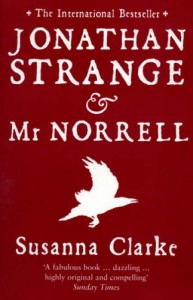 Today I’ll be reviewing Jonathan Strange & Mr Norrell, but before I make any comments I have to preface them with a sad, awful fact: I’ve been reading this book since January.
Today I’ll be reviewing Jonathan Strange & Mr Norrell, but before I make any comments I have to preface them with a sad, awful fact: I’ve been reading this book since January.
Yeah, it’s a bit of a beastie when it comes to length. My mass market paperback runs to 1,006 pages. But the length was no reason to take so long. Life happened, and my leisure reading suffered for it. As a result, my impressions of this novel are spread over nine months, so take pretty much anything I say about it with a hearty grain of salt.
Especially this first comment: The plot was pretty disjointed and full of vignette-style stories and incidents. That isn’t to say it wasn’t enjoyable, just that it was very, very hard to come back to when I was short on time, especially since I new section and chapter breaks were few and far between (I hardly ever stop mid-scene, but while reading this novel I had to on more than one occasion).
To somewhat support my point, please note that the book is called Jonathan Strange & Mr Norrell and you don’t meet Jonathan Strange until page 243. In fact, I think he is only obliquely mentioned once or twice before then (excluding footnote references), and you only notice the mentions because his name is on the cover.
However, the book is full of delightful descriptions and immersive prose and circumstances (everything about the book is geared to immerse you in the alternate history—even the spelling). If read in a more sustained manner, it would probably be rich with an atmosphere that lingered when you had to put it down. Clarke’s descriptions of fairy things are full of synesthesia and mixed metaphors, and it works perfectly because the fairies are not quite human and live in a place that is just a sidestep shy of our reality. An example: “[The fairy box] was a beautiful shade of blue, but then again not exactly blue, it was more like lilac. But then again, not exactly lilac either, since it had a tinge of grey in it. To be more precise, it was the color of heartache. But fortunately neither Miss Greysteel nor Aunt Greysteel had ever been much troubled by heartache and so they did not recognize it.” The descriptions are brilliant and they’re done with precision and deliberation.
Overall, the plotting was not my favorite (probably a symptom of the nine-month read). I think it could have done with more focus and some quicker pacing. Even so, the novel definitely has texture. The worldbuilding is deep and full, complete with folktales (which of course made me happy). The characters are hardly stereotypes, and even when they don’t act exactly as you thought they would, they are still acting perfectly (or perhaps brokenly) human. Mr. Norrell is someone I didn’t like, but I couldn’t help but empathize with him on many occasions.
My final note will be somewhat redemptive for the plot: After I picked the book up for the homestretch sprint of reading I started close to a chapter called “A little box, the color of heartache.” From that chapter on I quite enjoyed the pacing and the conflict up to the finish. The end relied on a bit of what felt like deus ex machina, but what with a prophecy being in the book from the beginning, it isn’t so bad and probably wouldn’t have stung so much if I could actually remember any of the prophecy by the time I got to the end.
Bottom line: I dropped the ball as a reader on this one. Sorry, Susanna Clarke. I’m perfectly willing to give it another try if you put out another book (short story collection excluded for the moment due to the stack of to-read books next to my desk).




Leave a Reply